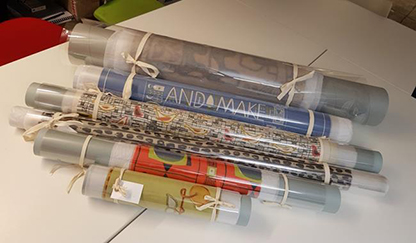You may remember we told you about our textile repackaging project, involving hundreds of items from our textile collection. Well, we thought it was time to update you on what the textile storage looks like now that it’s complete!
As part of the recovery project, textiles have been repackaged in two main ways. Firstly, small to medium size pieces have been packaged using a modular storage system, with folders and boxes (folders for flat items, and boxes for more 3D items like tea cosies) of set sizes and varying depths providing safe and secure homes. The image below shows two of our textile items in their new storage – you can see the different depths of the folders and boxes based on the size of the contents and the use of blue calico lining for light-coloured textiles to show them to best advantage. The folders and boxes are versatile so that they can be used for storage, transportation and display.

Textile items in modular storage in use at a conservation workshop
Secondly, larger and flatter pieces were rolled onto cardboard tubes of varying lengths and diameters. This allows them to be removed from storage individually, no other items are stored on top of them and they are protected for current and future use.

Larger textiles have been rolled onto conservation grade tubes, allowing easy retrieval
Both the modular folder and trays, and the rolled textiles are now housed in our new textile storage system which has been installed over recent months. It comprises bespoke drawers of varying depths to accommodate different depths of boxes and trays, and different diameters of rolls. The design of the storage system optimises the storage space available without overloading drawers and allows easy retrieval of individual items. The grey boxes on top of the drawers house large and bulky textiles, i.e. full size garments such as dresses and shirts.

Drawer sizes are designed to make maximum use of space and to accommodate different sizes of boxes and rolls
The modular system works well, like a jigsaw with storage of boxes configured such that they fit together to fill the space. All boxes are labelled as are the front of the drawers, so it is easy to see what is in each drawer. The images below show drawers housing full-size, half-size and quarter-size boxes and trays, which have been grouped by collection and by size to make maximum use of the space available. There is space afforded between the box edge and the drawer edge to allow us to reach in and lift the boxes out.


The drawers allow versatile storage combinations
For the rolled textiles, we have adopted the approach taken by the Smithsonian Institute, with tubes on aluminium spindles which can be lifted out one at a time from their cradles. This reduces handling of other textiles which are not needed, if only the one of interest is being lifted out. The system also allows for smaller rolls to be placed alongside each other on one spindle, optimising the use of space. Again, the drawer fronts are labelled and the textiles can be clearly seen on each roll through the Melinex covering. In some cases, it may not be necessary for researchers to unroll the textile if detail can be seen through the Melinex – this can further reduce unnecessary handling, all the better for preservation.

Rolled textiles are placed on their spindles so no weight is put upon them
Another approach which has been taken to help with identifying and selecting textile rolls of interest is to place a photographic label on each roll showing the textile. This has been possible following the extensive photographic project carried out over the last 18 months. It gives sight of the whole textile so researchers can decide if they would like it unrolled or not, and helps us ensure we have picked the right roll!

The textile labels give a great overview of the whole piece
Now that the storage system is in place and in use, it makes our retrieval process a lot easier and more efficient, and we know that our textile collection is safe and secure.
The next step is to install cabinets to house our object collection, for more efficient retrieval and re-housing after use. We intend to have them in open storage and have been visiting other institutions to see how they store their objects. Unfortunately this work will have to wait until the Archives & Collections re-opens but we will keep you updated on its progress once it happens!

